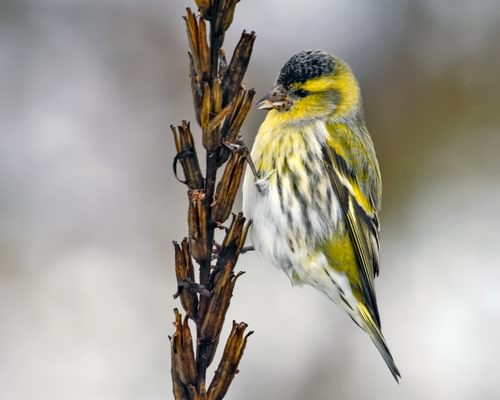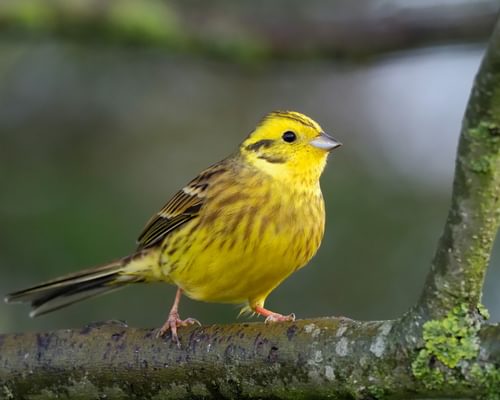Serin
Least ConcernSerinus serinus
Visual Identification
Appearance
The Serin is a small, compact finch with a short, stubby bill. Males display bright yellow-green plumage on the face, throat, and breast, contrasting with brown-streaked upperparts. Their wings feature distinctive yellow wing bars.
Females are duller, with more subdued yellows and heavier streaking. Both sexes have forked tails and brownish-pink legs. Juveniles resemble females but have even less yellow colouration. During winter, both sexes' plumage becomes slightly duller.
Size
Length
11cm to 12cm
Wingspan
20cm to 23cm
Weight
10g to 15g
Habitat and Distribution
Habitats
Woodland
Garden
Wetland
Coastal
Urban
Farmland
Grassland
Desert
Tundra
Rainforest
Mountain
Savanna
Distribution
Serins inhabit a wide range of open habitats across Europe, North Africa, and parts of the Middle East. They prefer areas with scattered trees, such as open woodlands, orchards, parks, and gardens.
In winter, many northern populations move southward, while those in southern Europe and North Africa tend to be resident. In the UK, Serins are rare visitors, mainly observed along the south and east coasts during migration periods.
Reports of UK breeding pairs are sporadic, with only one or two pairs noted each year. These sightings are limited to eastern and southern England, Devon, Dorset, Sussex and East Anglia, and occasionally on the Channel Islands.
Elevation Range
Up to 2,000 meters
Climate zones
Temperate, Mediterranean
Distribution Map
This map gives you a rough idea of where you might spot a Serin. The coloured areas show countries where these birds have been seen.
A few things to keep in mind:
- Birds might not be everywhere in the coloured areas, for example, they may be present around the coast of that country
- Where birds live can change with seasons and available food
- This map is quite simple - it doesn't show exact locations
We're working on making our maps even better! Soon, we hope to show you:
- More detailed maps for bigger countries, including state and region
- How birds move around during different seasons
Distribution by Region
Behaviour and Ecology
Bird Attributes
This feature is in beta. We'd love your feedback to improve it!
Share your thoughtsBird Attributes Explained
Our bird attributes system rates various aspects of a bird's capabilities on a scale of 0-100, based on data from field observations, scientific studies, and expert knowledge.
Attribute Categories:
- Agility: Manoeuvrability, speed, and grace in flight or movement.
- Strength: Physical power, often correlating with size and hunting abilities.
- Adaptability: Ability to thrive in various environments or changing conditions.
- Aggressiveness: Territorial behaviour and assertiveness, particularly during breeding seasons.
- Endurance: Stamina, often seen in migration patterns or foraging behaviours.
Understanding the Ratings:
- 0-20: Very Low
- 21-40: Low
- 41-60: Average
- 61-80: High
- 81-100: Very High
Remember, these attributes are relative to other bird species and don't necessarily indicate superiority.
Hover over the icon next to each attribute for more information.
Tap the icon next to each attribute for more information.
Agility
Reflects the bird's manoeuvrability, speed, and grace in flight or movement.
The Serin demonstrates remarkable agility, being described as active and acrobatic. Their ability to flit between branches, hang upside down on seed heads, and perform elaborate flight displays during courtship indicates a high level of manoeuvrability and dexterity.
Strength
Indicates the bird's physical power, often correlating with size and hunting abilities.
As one of the smallest finches in Europe, weighing only 10-15 grams, the Serin's strength is quite limited. Their primary activities involve foraging for small seeds and constructing small nests, which don't require significant strength.
Adaptability
Represents the bird's ability to thrive in various environments or changing conditions.
Serins show good adaptability, inhabiting a wide range of open habitats across Europe, North Africa, and parts of the Middle East. Their ability to thrive in various environments, including urban areas, and their partial migratory behaviour demonstrate considerable adaptability.
Aggressiveness
Measures the bird's territorial behaviour and assertiveness, particularly during breeding seasons.
Serins are not notably aggressive birds. They often gather in small flocks and their breeding behaviour doesn't indicate high levels of aggression. However, like most birds, they likely defend their territories during breeding season, hence a low-moderate score.
Endurance
Reflects the bird's stamina, often seen in migration patterns or foraging behaviours.
While small, Serins display decent endurance. Their ability to undertake partial migrations, perform extended flight displays during courtship, and raise multiple broods in a season suggests moderate endurance. However, their small size limits their overall stamina compared to larger birds.
Diet
Serins primarily feed on small seeds from various plants, including grasses, dandelions, and thistles.
They supplement their diet with buds, young leaves, and occasionally small insects, including spiders, larvae and grasshoppers, especially during the breeding season when feeding their young.
Behaviour
Serins are active and agile birds, often seen flitting between branches or hopping on the ground. They frequently gather in small flocks, especially outside the breeding season.
When feeding, Serins can be observed hanging upside down on seed heads, showcasing their acrobatic skills.
Vocalisation
Unlike the tuneful melody of their close cousin, the canary, the Serin's song is a rapid, high-pitched trill, often described as sounding like a tiny bell or a bunch of jangling keys. It's typically delivered from a prominent perch or during flight. Their call is a soft, plaintive 'tsi-tsi' or 'tsilip'.
The delicate rapid notes, sung almost exclusively by the male, can be heard all year round, although less frequently in autumn and winter.
Nesting & Breeding
Breeding season for Serins typically begins in April and can last until August. Males perform elaborate flight displays to attract females, singing while flying in wide circles.
Nests are small, neat cups made of fine twigs, grass, and moss, lined with feathers and plant down. They are usually placed in the outer branches of trees or shrubs. Females lay 3-4 pale blue eggs with dark spots.
Incubation lasts about 13 days, carried out by the female. Both parents feed the chicks, which fledge after 15-18 days. Pairs often raise two or three broods per season.
Lifespan
The Serin typically lives for 2 to 3 years, with a maximum recorded lifespan of 13.3 years.
Like all birds, lifespan can be affected by factors including predation, habitat quality, disease, and access to food sources.
Conservation and Status
Global Conservation Status
While the Serin is currently listed as Least Concern, some local populations have experienced declines due to habitat loss and agricultural intensification.
Conservation efforts focus on maintaining diverse habitats and promoting wildlife-friendly farming practices in their range.
Birdwatching Tips
- Look for Serins in open woodlands, parks, and gardens with scattered trees
- Listen for their high-pitched, rapid-trilling song, often delivered from treetops
- Observe feeders in urban areas, where they may visit for seeds
- In the UK, focus on southern coastal areas during spring and autumn migrations
Additional Information
Quick Facts
Other names:
European Serin
Family:
FringillidaePredators
Serins are preyed upon by various small raptors such as Sparrowhawks and Merlins, as well as domestic cats in urban areas.
Did You Know?
- Serins are one of the smallest finches in Europe.
- Their scientific name, Serinus serinus, is an example of a tautonym, where the genus and species names are identical.
- In some regions, Serins have adapted well to urban environments and can be common in city parks and gardens.
Was this bird profile helpful?
Your feedback helps us improve our content
Thanks for your feedback!
Your input helps us improve our content.
Community Experience
Community Ratings
No ratings yet - be the first to rate this bird!
Latest Community Reviews
No reviews yet
Sign in to be the first to review
Community Reviews
Create Your Free Account Welcome Back!
Join our community to rate birds and share your experiences. Creating an account is completely free and only takes a minute. Sign in to your account to rate birds and share your experiences with our community.
Your information is secure and will never be shared.
By creating an account, you agree to our Privacy Policy.
FAQs
How to pronounce Serin
The species name comes from ‘serin’, the French word for a canary. It’s pronounced ‘seh-rin’.
Similar Birds
References
- 2 3
website: BirdLife International. 2018. Serinus serinus. The IUCN Red List of Threatened Species 2018: e.T22720049A132136209.
View source - 4
report, 2015: EBCC
- 1
website, 2010: Fransson et al., EURING list of longevity records for European birds
View source

